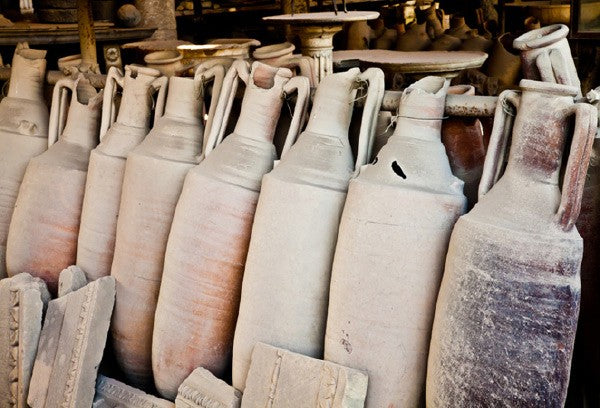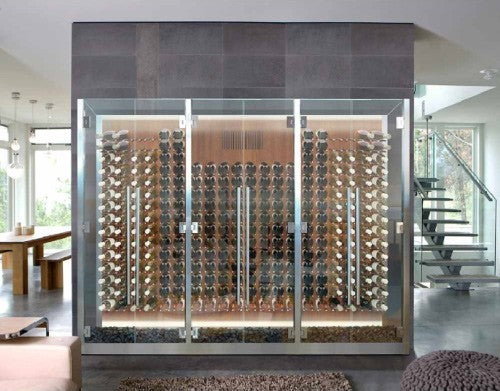The Origins of Aging Wine
Image source: Pexels.com
How Wine Aging Started
Are you a fan of wine? Are you unsure of whether or not to invest in a wine cellar? Below we explore the history of aging wine, the vessels used, the chemistry behind aging and why cellaring is important.
The basics of wine storage, whether modern or ancient are as follows:
1. Oxidization must be prevented.
2. Wine must be stored in a container that cannot easily break and that ideally does not interact with the wine.
3. Darker conditions are best.
4. Wine prefers a stable temperature and should not be exposed to excessive heat.
The basics of wine storage, whether modern or ancient are as follows:
1. Oxidization must be prevented.
2. Wine must be stored in a container that cannot easily break and that ideally does not interact with the wine.
3. Darker conditions are best.
4. Wine prefers a stable temperature and should not be exposed to excessive heat.
History
Considering these basics, let us begin with a brief history on the aging of wine. During the time of the Ancient Greeks and Romans, wine was stored and moved in earthenware containers called amphorae (pictured below). Amphorae were also used to store other liquids such as olive oil. Eventually, wine would be stored in palm wood barrels which were difficult to construct because palm wood is very hard and difficult to manipulate. Neither the palm wood or amphorae were practical solutions for wine storage or transport. As the Roman Empire began to invade Norther Europe, they discovered the use of oak barrels for beer and began to adapt this method for wine. These barrels weighed less and were more fit for transport.
Ancient Amphorae Source
It was not until the 17th century that wine makers began to use a glass bottle and cork. This was a radical development because it allowed producers to package and store wine in an air-tight environment as well as transport wine easily all over the world.
How do we know that ancient civilizations aged wine thousands of years ago? Archaeologists have unearthed clues and relics that point to wine aging in dark cool places like in underground cemetery tunnels or specially built wine caves. Romans used to bury amphorae in the ground to help regulate the temperature. It was acknowledged that aging would enhance the wine’s characteristics, adding complex scents and flavors.
As the process of aging wine evolved, the basic principles of wine making remained the same; light, temperature, humidity, and movement had to be controlled in order to successfully age wine. Today we have more convenient methods of wine storage that can maintain the necessary conditions that do not require acquiring a cave or storing wine in a catacomb. Modern wine storage is Vinotemp’s specialty, offering our customers their own wine cellar in the privacy of their home or business.
How do we know that ancient civilizations aged wine thousands of years ago? Archaeologists have unearthed clues and relics that point to wine aging in dark cool places like in underground cemetery tunnels or specially built wine caves. Romans used to bury amphorae in the ground to help regulate the temperature. It was acknowledged that aging would enhance the wine’s characteristics, adding complex scents and flavors.
As the process of aging wine evolved, the basic principles of wine making remained the same; light, temperature, humidity, and movement had to be controlled in order to successfully age wine. Today we have more convenient methods of wine storage that can maintain the necessary conditions that do not require acquiring a cave or storing wine in a catacomb. Modern wine storage is Vinotemp’s specialty, offering our customers their own wine cellar in the privacy of their home or business.
The Chemistry of Aging Wine
Wine is made from a complex mix of chemical compounds that can alter and react with one another as well as the environment surrounding them. Below we list some of the chemical compounds and reactions that alter wine as it ages:
• Esters: These are chemical compounds that form when the alcohol reacts to the acid in the wine. They are responsible for the aromatic, fruit-like compounds in the wine that are formed during fermentation.
• Phenolic Compounds: These compounds are responsible for the mouthfeel, color, and taste of wine. The most important phenolic compound in wine is called tannins. The tannins give certain wines a dry and bitter after taste, but over time, the tannins bind and settle as sediment at the bottom of the wine bottle.
• Oxygen: Exposure to oxygen can be both good and bad. On the positive side, the wine can develop more earthy or nutty flavors. Conversely, the wine may oxidize and become too acidic, vinegary, or may change color.
Aging wine is truly a science. With proper storage and care, wine can develop different aromas and flavors thanks to these chemical compounds. Wine ages best in a cool and constant environment with little to no temperature fluctuations. An 18 degree increase from the recommended 55◦F doubles the rate of chemical reactions. It is because of this that wine must be kept in a proper cellaring environment. Let Vinotemp Assist You with Your Cellar Aging wine is not easy. It is a process that has evolved for thousands of years and is dependent on different factors that influence the chemical composition of wine. Over time, people have developed more scientific and technologically advanced ways to work around the variables. Now that there are appliances such as wine refrigerators, wine cabinets, and/or wine vaults aging wine can be relatively painless. At Vinotemp, we can help you build a wine cellar and ensure the proper standards are in place to age wine successfully. Contact us with our Contact Form.
• Esters: These are chemical compounds that form when the alcohol reacts to the acid in the wine. They are responsible for the aromatic, fruit-like compounds in the wine that are formed during fermentation.
• Phenolic Compounds: These compounds are responsible for the mouthfeel, color, and taste of wine. The most important phenolic compound in wine is called tannins. The tannins give certain wines a dry and bitter after taste, but over time, the tannins bind and settle as sediment at the bottom of the wine bottle.
• Oxygen: Exposure to oxygen can be both good and bad. On the positive side, the wine can develop more earthy or nutty flavors. Conversely, the wine may oxidize and become too acidic, vinegary, or may change color.
Aging wine is truly a science. With proper storage and care, wine can develop different aromas and flavors thanks to these chemical compounds. Wine ages best in a cool and constant environment with little to no temperature fluctuations. An 18 degree increase from the recommended 55◦F doubles the rate of chemical reactions. It is because of this that wine must be kept in a proper cellaring environment. Let Vinotemp Assist You with Your Cellar Aging wine is not easy. It is a process that has evolved for thousands of years and is dependent on different factors that influence the chemical composition of wine. Over time, people have developed more scientific and technologically advanced ways to work around the variables. Now that there are appliances such as wine refrigerators, wine cabinets, and/or wine vaults aging wine can be relatively painless. At Vinotemp, we can help you build a wine cellar and ensure the proper standards are in place to age wine successfully. Contact us with our Contact Form.







